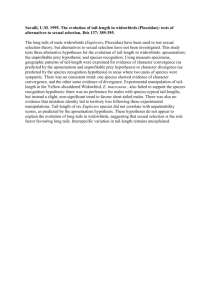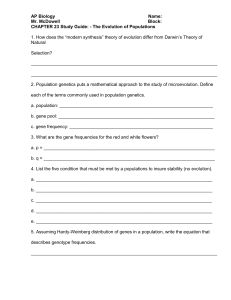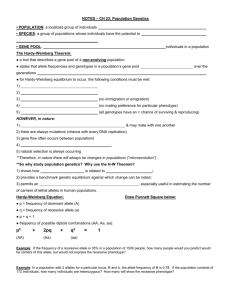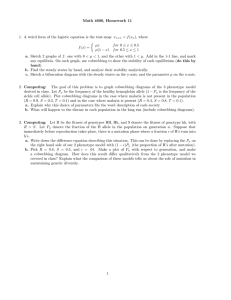Maternal effects and the evolution of aposematic signals
advertisement
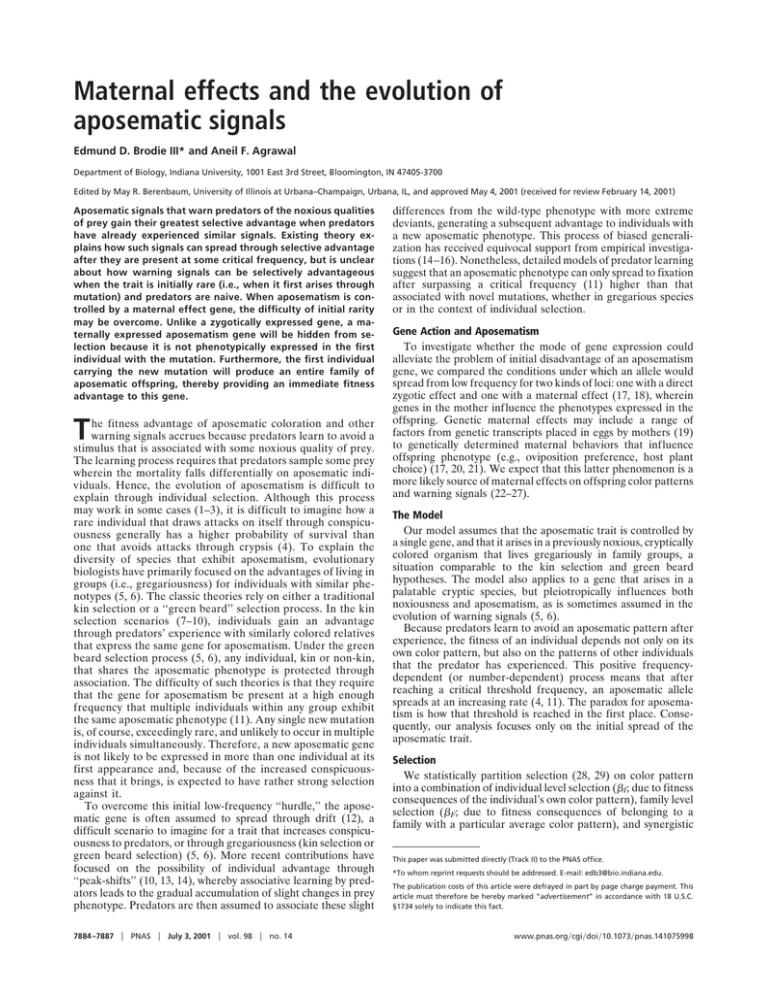
Maternal effects and the evolution of aposematic signals Edmund D. Brodie III* and Aneil F. Agrawal Department of Biology, Indiana University, 1001 East 3rd Street, Bloomington, IN 47405-3700 Edited by May R. Berenbaum, University of Illinois at Urbana–Champaign, Urbana, IL, and approved May 4, 2001 (received for review February 14, 2001) Aposematic signals that warn predators of the noxious qualities of prey gain their greatest selective advantage when predators have already experienced similar signals. Existing theory explains how such signals can spread through selective advantage after they are present at some critical frequency, but is unclear about how warning signals can be selectively advantageous when the trait is initially rare (i.e., when it first arises through mutation) and predators are naive. When aposematism is controlled by a maternal effect gene, the difficulty of initial rarity may be overcome. Unlike a zygotically expressed gene, a maternally expressed aposematism gene will be hidden from selection because it is not phenotypically expressed in the first individual with the mutation. Furthermore, the first individual carrying the new mutation will produce an entire family of aposematic offspring, thereby providing an immediate fitness advantage to this gene. T he fitness advantage of aposematic coloration and other warning signals accrues because predators learn to avoid a stimulus that is associated with some noxious quality of prey. The learning process requires that predators sample some prey wherein the mortality falls differentially on aposematic individuals. Hence, the evolution of aposematism is difficult to explain through individual selection. Although this process may work in some cases (1–3), it is difficult to imagine how a rare individual that draws attacks on itself through conspicuousness generally has a higher probability of survival than one that avoids attacks through crypsis (4). To explain the diversity of species that exhibit aposematism, evolutionary biologists have primarily focused on the advantages of living in groups (i.e., gregariousness) for individuals with similar phenotypes (5, 6). The classic theories rely on either a traditional kin selection or a ‘‘green beard’’ selection process. In the kin selection scenarios (7–10), individuals gain an advantage through predators’ experience with similarly colored relatives that express the same gene for aposematism. Under the green beard selection process (5, 6), any individual, kin or non-kin, that shares the aposematic phenotype is protected through association. The difficulty of such theories is that they require that the gene for aposematism be present at a high enough frequency that multiple individuals within any group exhibit the same aposematic phenotype (11). Any single new mutation is, of course, exceedingly rare, and unlikely to occur in multiple individuals simultaneously. Therefore, a new aposematic gene is not likely to be expressed in more than one individual at its first appearance and, because of the increased conspicuousness that it brings, is expected to have rather strong selection against it. To overcome this initial low-frequency ‘‘hurdle,’’ the aposematic gene is often assumed to spread through drift (12), a difficult scenario to imagine for a trait that increases conspicuousness to predators, or through gregariousness (kin selection or green beard selection) (5, 6). More recent contributions have focused on the possibility of individual advantage through ‘‘peak-shifts’’ (10, 13, 14), whereby associative learning by predators leads to the gradual accumulation of slight changes in prey phenotype. Predators are then assumed to associate these slight 7884 –7887 兩 PNAS 兩 July 3, 2001 兩 vol. 98 兩 no. 14 differences from the wild-type phenotype with more extreme deviants, generating a subsequent advantage to individuals with a new aposematic phenotype. This process of biased generalization has received equivocal support from empirical investigations (14–16). Nonetheless, detailed models of predator learning suggest that an aposematic phenotype can only spread to fixation after surpassing a critical frequency (11) higher than that associated with novel mutations, whether in gregarious species or in the context of individual selection. Gene Action and Aposematism To investigate whether the mode of gene expression could alleviate the problem of initial disadvantage of an aposematism gene, we compared the conditions under which an allele would spread from low frequency for two kinds of loci: one with a direct zygotic effect and one with a maternal effect (17, 18), wherein genes in the mother influence the phenotypes expressed in the offspring. Genetic maternal effects may include a range of factors from genetic transcripts placed in eggs by mothers (19) to genetically determined maternal behaviors that influence offspring phenotype (e.g., oviposition preference, host plant choice) (17, 20, 21). We expect that this latter phenomenon is a more likely source of maternal effects on offspring color patterns and warning signals (22–27). The Model Our model assumes that the aposematic trait is controlled by a single gene, and that it arises in a previously noxious, cryptically colored organism that lives gregariously in family groups, a situation comparable to the kin selection and green beard hypotheses. The model also applies to a gene that arises in a palatable cryptic species, but pleiotropically influences both noxiousness and aposematism, as is sometimes assumed in the evolution of warning signals (5, 6). Because predators learn to avoid an aposematic pattern after experience, the fitness of an individual depends not only on its own color pattern, but also on the patterns of other individuals that the predator has experienced. This positive frequencydependent (or number-dependent) process means that after reaching a critical threshold frequency, an aposematic allele spreads at an increasing rate (4, 11). The paradox for aposematism is how that threshold is reached in the first place. Consequently, our analysis focuses only on the initial spread of the aposematic trait. Selection We statistically partition selection (28, 29) on color pattern into a combination of individual level selection (I; due to fitness consequences of the individual’s own color pattern), family level selection (F; due to fitness consequences of belonging to a family with a particular average color pattern), and synergistic This paper was submitted directly (Track II) to the PNAS office. *To whom reprint requests should be addressed. E-mail: edb3@bio.indiana.edu. The publication costs of this article were defrayed in part by page charge payment. This article must therefore be hereby marked “advertisement” in accordance with 18 U.S.C. §1734 solely to indicate this fact. www.pnas.org兾cgi兾doi兾10.1073兾pnas.141075998 Table 1. Phenotypic trait values for genotypes with zygotic and maternal expression Expression Zygotic Maternal Individual’s genotype Individual’s phenotype Z C ZC ZAZC ZAZA MCMC MAMC MAMA ⫺1 d 1 Offspring’s phenotype Conditions for the Spread of a Rare Aposematism Allele Using the fitness equation (1), we compare the fitness differences of aposematism and crypsis alleles. The fitness difference between zygotically expressed aposematism, w(ZA), and crypsis, w(ZC), alleles under single mating is w共Z A 兲 ⫺ w共Z C 兲 ⫽ 共1 ⫹ d兲共  I ⫹ 0.5  F 兲 ⫹ 0.25共1 ⫹ d兲 2  S ⫺ p共2d  I ⫹ d  F ⫹ 共0.5 ⫹ 4d ⫹ d 2 兲  S 兲 ⫺1 d 1 ⫹ p 2 d共4 ⫹ 1.5d兲  s ⫺ p 3 d 2  s [2] and under multiple mating is d, level of dominance of aposematic allele. w共Z A 兲 ⫺ w共Z C 兲 ⫽ 共1 ⫹ d兲共  I ⫹ 0.25  F 兲 ⫹ 0.625共1 ⫹ d兲 2  S selection (S; due to fitness consequences of the individual’s color pattern occurring in the context of the family’s average color pattern): ⫺ 3p 3 d 2  s . [1] where zij is the phenotype (i.e., level of aposematism) of the jth individual in the ith family and z䡠 is the mean phenotype of the ith family. This equation can be used to describe a wide variety of selection regimes. Our partitioning of selection makes no assumptions about the ecological interactions that generate selection. The details of predator perception, avoidance learning, foraging behavior, and frequency-dependence that are clearly integral to the evolution of aposematism (4, 11) can be incorporated by substituting the appropriate fitness functions in place of our -terms. For example, we might expect that individual selection, I, is a function that is negative when the aposematic allele is rare and positive when the allele is common. We adopt a general model of selection so that we can compare the influence of mode of inheritance within a given selection scenario. We identify the relative strengths of selection at different levels required to cause the spread of a rare aposematism allele with zygotic or maternal effects. Therefore, we investigate the case where the frequency of the aposematic allele, p, is very low and predators are unlikely to encounter multiple families that express the aposematic trait. Because we examine the case where p is very small, we need only consider the relative signs and magnitudes of the selection coefficients rather than explicitly model how they change as a function of p. If an aposematic allele can spread when rare, it is expected to spread from any intermediate frequency because of positive frequency-dependent selection. We evaluate the spread of an aposematism allele through either maternal or direct zygotic effects with a variable level of dominance, d (Table 1). We explicitly discuss the case of an advantage through gregariousness, although alternative selection scenarios can be incorporated. Gregariousness-based hypotheses of the evolution of aposematism (6, 8–10) assume that when the aposematism allele is rare, most cryptic individuals occur in families composed of other cryptic individuals and have fitness k. Aposematic individuals living in families consisting mostly of cryptic individuals have fitness ⬍ k, whereas aposematic individuals living in families consisting mostly of other aposematic individuals have fitness ⬎ k. This type of selection is captured statistically in our fitness function (Eq. 1) by setting I, S ⬍ 0, and F ⬎ 0. Because the fitness of aposematic individuals depends on their frequency within families, the net selection on aposematism depends on the distribution of aposematic individuals among families. For any given frequency of the aposematic allele, p, this distribution is a function of the mating system, degree of dominance, and mode of gene action. Brodie and Agrawal ⫹ 2.75d 2 兲  S 兲 ⫹ p 2 d共8 ⫹ 4.5d兲  s [3] Regardless of mating system, the fitness difference of maternally expressed aposematism, w(MA), and crypsis, w(MC), alleles is w共M A 兲 ⫺ w共M C 兲 ⫽ 共  I ⫹  F 兲共0.5共1 ⫹ d兲 ⫺ dp兲. [4] A rare aposematism allele is assumed to spread when its fitness is greater than that of the crypsis allele [i.e., w(ZA) ⫺ w(ZC) ⬎ 0 or w(MA) ⫺ w(MC) ⬎ 0]. We evaluate this condition relative to family level selection, F, but the inequality can be rearranged to compare with other modes of selection. A zygotically expressed aposematism allele under single mating will spread when 2 F ⬎ ⫺ 1 ⫹ d共1 ⫺ 2p兲 冢 I共1 ⫹ d兲 ⫹ 0.25共1 ⫹ d兲2S 冣 ⫺ p共2dI ⫹ 共0.5 ⫹ 4d ⫹ d2兲S兲 . ⫹ p2d共4 ⫹ 1.5d兲s ⫺ p3d2s [5] The same allele spreads under multiple mating when F ⬎ ⫺ 4 1 ⫹ d共1 ⫺ 2p兲 冢 I共1 ⫹ d兲 ⫹ 0.625共1 ⫹ d兲2S 冣 ⫺ p共2dI ⫹ 共1.25 ⫹ 8d ⫹ 2.75d2兲S兲 . ⫹ p2d共8 ⫹ 4.5d兲s ⫺ 3p3d2s [6] A maternally expressed aposematism allele under either mating system will spread when  F ⬎ ⫺  I. [7] Discussion When a new aposematism allele first arises through mutation, its frequency, p, is therefore quite small and all terms in Eqs. 2–6 that include p are negligible. In this case, the conditions necessary for an increase in frequency of a rare aposematism allele, assuming random single mating by females, for zygotic effects are  F ⬎ ⫺2I ⫺ 0.5S共1 ⫹ d兲 [8] and for maternal effects are  F ⬎ ⫺  I. [9] Offspring from the same family can have different genotypes and express different phenotypes whenever a trait is controlled by a zygotically expressed gene (i.e., phenotypic variance exists within families). When the aposematism allele is at low frequency, PNAS 兩 July 3, 2001 兩 vol. 98 兩 no. 14 兩 7885 EVOLUTION W共z ij 兲 ⫽ ␣ ⫹  I z ij ⫹  F z i䡠 ⫹  S 共z ij ⫺ z i䡠兲 2 ⫺ p共2d  I ⫹ 0.5d  F ⫹ 共1.25 ⫹ 8d Fig. 1. Conditions for the spread of a rare aposematism allele under single mating. The plots show the combinations of synergistic selection (S) and family selection (F) that allow an aposematism allele to increase in frequency from an initial value of P ⫽ 0.01 assuming individual selection, I ⫽ ⫺0.1. The shaded area in each plot indicates the conditions for the spread of a maternally expressed aposematism gene and the hatched area indicates the conditions for the spread of a zygotically expressed aposematism gene. Conditions are based on the full Eqs. 5 and 7. Fig. 2. Conditions for the spread of a rare aposematism allele under multiple mating. The plots show the combinations of synergistic selection (S) and family selection (F) that allow an aposematism allele to increase in frequency from an initial value of P ⫽ 0.01 assuming individual selection, I ⫽ ⫺0.1. The shaded area in each plot indicates the conditions for the spread of a maternally expressed aposematism gene and the hatched area indicates the conditions for the spread of a zygotically expressed aposematism gene. Conditions are based on the full Eqs. 6 and 7. aposematic individuals will tend to be found in families where 50% or more of their siblings are cryptic and synergistic selection retards the initial spread of aposematism (Eq. 8). A trait controlled by a maternally expressed gene causes all offspring to share the same phenotype regardless of their individual genotypes (i.e., there is no phenotypic variance within families), so synergistic selection does not counter the spread of aposematism (Fig. 1; Eq. 9). If females mate with multiple males, the conditions necessary for an increase of a zygotically expressed aposematism allele are matism gene because the distribution of aposematic individuals among families changes. Multiple mating results in the same global frequency of aposematism being dispersed among families, relative to the clumping within families produced under single mating. Conversely, we predict that population structure and兾or positive assortative mating would relax the conditions for the evolution of aposematism because they cause aposematic alleles to be concentrated within particular families. Multiple mating does not affect the conditions for the spread of a maternally expressed aposematism allele because the phenotype of all of the offspring within a family are determined only by their mother’s genotype (18). Overall, the conditions necessary for the spread of an aposematism allele are much less restrictive for a maternally expressed gene than for a zygotically expressed gene (Fig. 1). These  F ⬎ ⫺4I ⫺ 2.5S共1 ⫹ d兲, [10] whereas the conditions remain unchanged for maternal effects (Fig. 2; Eq. 9). Multiple mating presents an even greater barrier for the initial spread of a zygotically expressed apose7886 兩 www.pnas.org兾cgi兾doi兾10.1073兾pnas.141075998 Brodie and Agrawal differences are amplified as the frequency of multiple paternity increases (Fig. 2). Compared with zygotic expression, we see that maternally expressed aposematism evolves twice as easily under single mating and four times as easily under multiple mating (Eqs. 8–10, assuming S ⬵ 0). Maternally expressed aposematism accrues an even greater advantage when there is synergistic selection (i.e., S ⬍ 0). Again, these results assume only relative strengths of selection, not specific fitness functions. The analyses above do not apply to the individual bearing the original mutation, for which the advantage of maternal expression is even more obvious. A dominant (or partially dominant) zygotic mutation will first be expressed in a single individual found in an otherwise cryptic family and is expected to experience strong negative individual and synergistic selection. Even if such an individual somehow survives and reproduces, only 50% of its offspring will express the aposematic phenotype. A recessive zygotic allele, on the other hand, will be hidden from selection and will be phenotypically expressed only in 25% of the progeny of mating heterozygotes. In either case, the first aposematic individuals are found in groups that have a frequency of aposematism equal to or less than 0.50. With maternal effects, the initial mutation is not phenotypically expressed in the individual that carries it, regardless of dominance, nor in its progeny if it is male. Thus, like a recessive zygotically acting allele, a novel maternal mutation is effectively neutral in the first individual to carry it. However, unlike a recessive zygotically acting allele, in the next generation a maternal gene affects 100% of the offspring of the individual bearing the original mutation so the offspring share the same aposematic phenotype regardless of their own genotypes. As with zygotic effect genes, a recessive maternal effect allele would have to drift to high enough frequency that homozygous mothers are produced, at which time their offspring would still be 100% aposematic regardless of the genotype of the father. Our results do not imply that maternal effects are universally responsible for the evolution of aposematism, but rather that maternal effects evolve much more readily than zygotic effects under typical selection scenarios. Maternal inheritance of aposematic color patterns is known in some insects (e.g., spot size in ladybird beetles; ref. 19), but has not been widely investigated. There are few cases in which the genetics of aposematic signals are understood and these are primarily limited to lepidopteran systems (4, 30, 31). Although these studies do not provide wide evidence for maternal effects, the shortage of examples may result from the scarcity of attempts to identify maternal effects or the failure to recognize indirect consequences of maternal traits such as oviposition preference (20). Any gene expressed in a mother (or father) that causes her (his) offspring to exhibit a particular phenotype would fit the model of a maternally (paternally) expressed aposematism gene presented here; similar genes are known to influence a variety of characters in diverse taxa (17, 21, 32). Such phenomena could include nutrients and resources provisioned by parents to eggs or offspring, physical environments chosen by parents for progeny, or maternal transcripts present in eggs. Genetically based oviposition and host-plant preferences are well known among insects (33, 34). In turn, coloration and morphology in many insects are dramatically influenced by early larval environment, including polymorphisms of cryptic and aposematic forms in the geometrid moth Nemoria (23) and desert locusts of the genus Schistocerca (22, 35). Differences in larval diet are known to alter the redness of some lygaeid bugs (36) and ladybird beetles (37). Both juvenile and adult diets alter palatability through sequestration of plant compounds as observed in arctiid moths, Utetheisa (25, 26), and may similarly alter olfactory warning signals (24). These sorts of indirect effects of genetically based oviposition or dietary preferences may be one common way that genetic maternal effects can promote the early evolution of aposematic signals. Järvi, T., Sillén-Tullberg, B. & Wiklund, C. (1981) Oikos 36, 267–272. Wiklund, C. & Jarvi, T. (1982) Evolution (Lawrence, Kans.) 36, 998–1002. Sillén-Tullberg, B. (1985) Oecologia 67, 411–415. Mallet, J. & Joron, M. (1999) Annu. Rev. Ecol. Syst. 30, 201–233. Guilford, T. (1988) Am. Nat. 131, S7–S21. Guilford, T. (1990) in Insect Defenses: Adaptive Mechanisms and Strategies of Prey and Predators, eds. Evans, D. L. & Schmidt, J. O. (State Univ. N.Y. Press, Albany, NY), pp. 23–61. Fisher, R. A. (1930) The Genetical Theory of Natural Selection (Oxford Univ. Press, Oxford). Harvey, P. H., Bull, J. J., Pemberton, M. & Paxton, R. J. (1982) Am. Nat. 119, 710–719. Guilford, T. (1985) Oikos 45, 31–36. Leimar, O., Enquist, M. & Sillén-Tullberg, B. (1986) Am. Nat. 128, 469–490. Servedio, M. R. (2000) Evolution (Lawrence, Kans.) 54, 751–763. Endler, J. A. (1988) Philos. Trans. R. Soc. London B 319, 505–523. Yachi, S. & Higashi, M. (1998) Nature (London) 394, 882–884. Lindström, L., Alatalo, R. V., Mappes, J., Riipi, M. & Vertainen, L. (1999) Nature (London) 397, 249–251. Alatalo, R. V. & Mappes, J. (1996) Nature (London) 382, 708–709. Gamberale-Stille, G. & Tullberg, B. S. (2000) Evol. Ecol. 13, 1–11. Wolf, J. B., Brodie, E. D., III, Cheverud, J. M., Moore, A. J. & Wade, M. J. (1998) Trends Ecol. Evol. 13, 64–69. Wade, M. J. (2001) Evolution (Lawrence, Kans.) 55, 453–458. Holloway, G. J., Brakefield, P. M., De Jong, P. W., Ottenheim, M. M., De Vos, H., Kesbeke, F. & Peynenburg, L. (1995) Philos. Trans. R. Soc. London B 348, 373–379. 20. Wade, M. J. (1999) in Maternal Effects as Adaptations, eds. Mousseau, T. & Fox, C. (Oxford Univ. Press, New York). 21. Mousseau, T. A. & Fox, C. W. (1998) Maternal Effects as Adaptations (Oxford Univ. Press, New York). 22. Sword, G. A. (1999) Nature (London) 397, 217. 23. Greene, E. (1989) Science 243, 643–646. 24. Aldrich, J. R., Leal, W. S., Nishida, R., Khrimian, A. P., Lee, C.-J. & Sakuratani, Y. (1997) Entomologia Experimentalis et Applicata 84, 127–135. 25. Bowers, M. D. (1990) in Insect Defenses: Adaptive Mechanisms and Strategies of Prey and Predators, eds. Evans, D. L. & Schmidt, J. O. (State Univ. N.Y. Press, Albany, NY), pp. 353–386. 26. Eisner, T., Eisner, M., Rossini, C., Iyengar, V. K., Roach, B. L., Benedikt, E. & Meinwald, J. (2000) Proc. Natl. Acad. Sci. USA 97, 1634–1639. (First Published February 4, 2000; 10.1073兾pnas.030532797) 27. Eisner, T. & Meinwald, J. (1995) Proc. Natl. Acad. Sci. USA 92, 50–55. 28. Lande, R. & Arnold, S. J. (1983) Evolution (Lawrence, Kans.) 37, 1210–1226. 29. Queller, D. C. (1992) Am. Nat. 139, 540–558. 30. Turner, J. R. G. (1977) Evol. Biol. 10, 163–206. 31. Sheppard, P. M., Turner, J. R. G., Brown, K. S., Benson, W. W. & Singer, M. C. (1985) Philos. Trans. R. Soc. London B 308, 433–613. 32. Agrawal, A. A., Laforsch, C. & Tollrian, R. (1999) Nature (London) 401, 60–63. 33. Thompson, J. N. & Pellmyr, O. (1991) Annu. Rev. Entomol. 36, 65–89. 34. Thompson, J. N. (1988) Evolution (Lawrence, Kans.) 42, 1223–1234. 35. Simpson, S. J., McCaffery, A. R. & Hägele, B. F. (1999) Biol. Rev. 74, 461–480. 36. Tullberg, B. S., Gamberale-Stille, G. & Solbreck, C. (2000) Ecol. Entomol. 25, 220–225. 37. Grill, C. P. & Moore, A. J. (1998) Heredity 78, 261–269. 7. 8. 9. 10. 11. 12. 13. 14. 15. 16. 17. 18. 19. Brodie and Agrawal PNAS 兩 July 3, 2001 兩 vol. 98 兩 no. 14 兩 7887 EVOLUTION 1. 2. 3. 4. 5. 6. We thank E. D. Brodie, Jr., M. Maple, A. Moore, B. Ridenhour, M. Wade, and S. Welter for discussions regarding maternal effects and aposematism and for comments on the manuscript. This work was supported by the National Science Foundation and Natural Sciences and Engineering Research Council (Canada).
